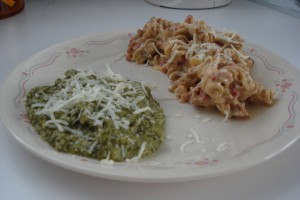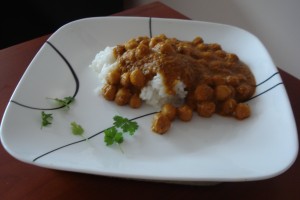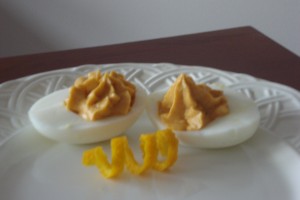Over Memorial Day Weekend, Sarah decided to avail herself of the Trailer, and asked Ted and I to accompany her. Not having any plans ourselves, we decided this was a capital idea.
The Trailer has been mentioned before, in my Blog of Yesteryear “Salamanca, Ho!”. Sarah’s parents own a single-wide trailer in Great Valley, New York, which is situated near Salamanca and Ellicottville, and near the Seneca Nation. Calling this abode a trailer doesn’t really do it justice: it’s got three bedrooms, a nice small living room with cable TV, and a full kitchen and dining area, plus a washer/dryer and whole-house air conditioning, which we might have broken. Sarah’s father, known popularly as Neilbert, grew up in Salamanca, and his brothers and many of his family members still reside there. Plus Neilbert is an avid skier, and so on many weekends, he and wife Saundra will venture up to New York to see the family and do some skiing, weather permitting. This was not one of those weekends, though, so off went the younger generation to enjoy the Trailer.

I felt like I learned a lot about the middle of nowhere in the gas station.
We drove through the middle of nowhere, PA, and though it’s actually a route I’d traveled before (See my
Blog of Yesteryear “Smethport, Ho!”), I’m always sort of amazed at how much straight-up Nothing there is in the world, and how many people are willing - I would assume even pleased - to live amongst so much Nothing. I realize Pittsburgh may not seem like The Big City to certain residents of New York, LA, or Chicago, but I assure you, when you get up near Kane, PA, Ted, Sarah, and I are City Folk, capital C capital F.
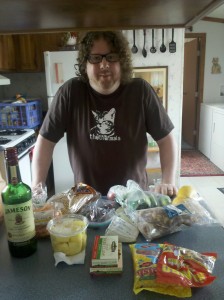
Ted and the Provisions
We arrived and unpacked. The Trailer having a kitchen and all, it seemed prudent to bring provisions, to save money. Grocery shopping is one of my favorite hobbies, so I was pleased to put together what I viewed as a wholesome and tasty array of comestibles: whole-seed bread, cheeses, mixed nuts, cucumbers, tomatoes, pineapple, mango fresh and dried, cherries, Swedish Fish, and most of a bottle of Irish Whiskey. Sarah also brought snacks, including wines, ingredients to make deviled eggs and Doritos - mmm, Doritos. Doritos are the sort of thing that I never buy, because I know that having bought them I will just eat them, and that’s just not good for me. And yet. Doritos. So good. The Trailer was well stocked indeed.
We enjoyed a late lunch - and learned that Sarah loves Swedish Fish - and then took a nap. See, here’s the beauty of the Trailer: there’s nothing to do. Now, if I had to spend a couple of weeks there, I might very well get bored. But for a long weekend it’s great. Because at home, when you do nothing, you feel guilty. There’s always some damn thing you could be doing at home - something you could be cleaning, some household project that needs addressed, some social contact you owe a call to … whatever it is, doing nothing at home is always a shirking of responsibility. But doing nothing at the Trailer? Why, it’s all that can be done! Naps all around!
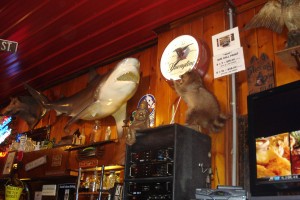
The Gin Mill had some colorful customers.
We awoke in the evening and headed into Ellicottville. Ellicotville is basically a one-block crossroads of nice things to do for the out-of-town skiiers who might not be completely satisfied with only what Salamanca has to offer; it’s got a microbrewery and a health food store and such things that the good small-town folk of rural Western New York may not have built on their own accord, had it not been for certain urban elements and their ski resorts. So much the better for us. We started out at a bar called
The Gin Mill, where a previous Internet check had revealed wings were served. Being only an hour or so from Buffalo, Ted was eager to try to the local wings, assuming that proximity to Buffalo and quality of wings increase proportionally. The trouble is that Ted doesn’t like Buffalo Wings, per se - as I’ve previously mentioned, he has a delicate tongue, and does not care for spicy things. So he ordered BBQ wings. To me, this defeats the entire experiment seeking to answer the question “Are Buffalo Wings Better the Closer One Gets to Buffalo?” - but he could not be dissuaded. Here was the interesting thing we learned: Ellicottville BBQ sauce is vinegary. Now, I’ve encountered vinegary, Carolina-style BBQ sauces before (mostly in the Carolinas, natch), and they’re good, no doubt. But I was not expecting to encounter one in Western New York. Well. Now you know. Ted proclaimed them very good. Also, Sarah and I sampled the curly fries, which the menu claims are hand-cut to order, and which were very good indeed.
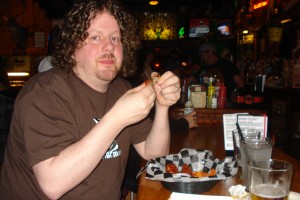
Ted gets down to business.
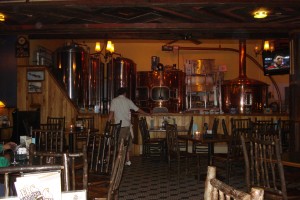
Where the magic happens.
From The Gin Mill, we headed over a block to the
Ellicottville Brewing Company, which brews its own beer and serves dinner. We tried several of the beers, one I’d had previously, the Blueberry Wheat, which is charmingly served with blueberries dancing in it. I tried the Pantius Droppius, an Imperial Pale Ale, Sarah got the Black Jack Oatmeal Stout, and Ted tried the Bourbon Barrel Imperial - all were fine brews. We also sampled and ended up buying a growler of the Catt County Cuvee, which was floral and well-balanced and very, very good.
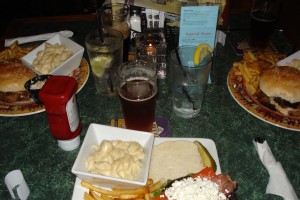
Dinner at the Ellicottville Brewing Company.
We also ate at the EBC, with somewhat mixed results. Ted and Sarah both ordered the pulled pork sandwich, which was very good - I sampled it. I got the portobello sandwich and asked for bacon on it, too, and that was also very good. We all got sides of mac and cheese, which was a little on the disappointing side, coming out sort of lukewarm and not as piquant as one might have hoped. Our meals were also served with fries, but mine were far too soggy from the escaping portobello juices to eat. Restaurants! If you intend to serve a portobello sandwich, you must serve sides on the actual side, in separate containers - the sandwich is just too messy to not have the mushroom juices swamp everything else on the plate. That is all.

The big winner.
Dying from the sheer amount of food we’d consumed, we took our growler and some leftovers (and a six-pack gift for Ted’s and my kittysitters, Carley and Will) and left Ellicottville. Ted wanted to try his luck at the Casino Niagara, which is operated by the Seneca Nation. Sarah and I aren’t gamblers, but we agreed to indulge Ted for a bit. The casino is large and nicely appointed. I’ve been in Vegas before, and while it’s not the Bellagio, it’s also modern and attractively designed. In 20 minutes Ted won $30 on the small-change slots, and we all considered this a success.
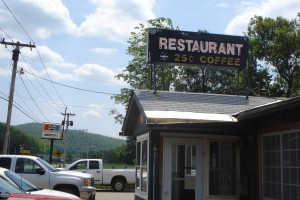
Langworthy's - now on Foursquare.
After our big day, we turned in early, and the next morning we headed out to Diner Breakfast. One of Ted’s favorite things to do while traveling is experience local diners, and we had plans to go to Eddy’s, just down the street from the Trailer. Alas, Eddy’s owners had closed up for the long weekend! And so we headed out of town to Langworthy’s, which is the second-smallest diner I’ve ever been in, and appears to serve the largest pancakes I’ve ever seen. Unfortunately I didn’t try the pancakes, only saw them from a distance - I had a perfectly good plate of eggs, potatoes, and bacon, and an absolutely fantastic biscuit. Sarah had cream chipped beef on toast, and Ted had an egg sammich. And we all had 25-cent coffee, as it seems to be the specialty of the house. And y’know, for 25 cents, it was good coffee. I mean, it wasn’t the best coffee I’ve ever had or anything, but seriously, at 25 cents it was a steal.
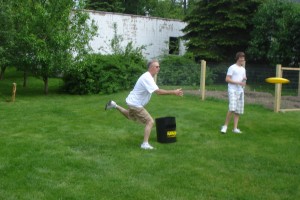
Local invention: Kan Jam. Jam Kan? Some such.
We lolligagged about for a bit, and then we headed over to Randolph, NY to go to Jenn and Trevor’s cook-out. Jenn and Trevor had occasioned my first stay at the Trailer, when I went to their wedding as Sarah’s date, as detailed in “Salamanca, Ho!”. Many of the same folk from the wedding were at the cook-out, including Sarah’s many Uncle -berts, and Uncle Howard, who may still think that Sarah and I are lesbian partners. If this is so, Ted’s presence was probably a minor mystery, but then, we could all three just be in a VERY progressive relationship, or perhaps Ted was just our egg donor subordinate. I was willing to spin off any of these tales, but Uncle Howard never asked. We got to meet Jenn’s and Trevor’s very cute furkids, including their rescued greyhouds, who are exactly what I like in a dog: calm and polite and quiet. Their heads are at hand-height, perfectly aligned for them to stand quietly next to you for an indefinite period of time while you rub their ears. We also were introduced to the game of
Kan Jam, which provides a purpose to Frisbee tossing, which I had always previously regarded as aimless and a bit silly. It involves two teams of two people each, trying to score points by tossing the Frisbee to and fro and trying to get it into the Kans - either by the non-throwing partner smacking it into the top of the Kan, or the throwing partner pulling off the feat of actually tossing the Frisbee through the slot in the side of the Kan. It seemed a pleasant diversion, and the rumor is that it is of local (Western NY) origin. It’s good to the support the local customs, though Ted and I sat around in the shade like city folk, getting itchy from being outside.
We left as the mosquitoes were coming out and a few rain drops were beginning to fall - a few raindrops that turned into an impressive storm. Home at the Trailer, Ted and I showered off the itch and then we all decided to do some drinking, since, c’mon, that’s what vacations are for. There was the growler of beer, the boxes of wine Sarah had brought, the whiskey, and some further provision raiding, including Sarah’s delicious, delicious Doritos. We all got a little drunk and I got bossy, commanding Ted to refill our drinks for us and other such things. Sarah also got misty-eyed talking about how much she loves Neilbert, which I figure he’ll be glad to hear. I ate a crap-ton of Doritos. A good time was had by all.
The next morning it was paralyzingly hot, a condition not alleviated on the trip home, as Sarah’s PT Cruiser’s air conditioner is broken - also I got quite queasy from carsickness. But let’s not dwell on these unfortunate facts! The point is, we had a nice time at the Trailer, and Ted and I would like to return - we never saw the Seneca Nation museum, or got to eat at Eddy’s, and Buffalo is about an hour away, so we could make a day trip from the Trailer of wing sampling. I also gather that there are some vineyards in the area, and I do like me some wine tasting. So in conclusion, Hooray for the Trailer. Saundra and Neilbert, I hope we didn’t break your air conditioning.
 OVEN-DRIED TOMATO MAC & CHEESE
OVEN-DRIED TOMATO MAC & CHEESE